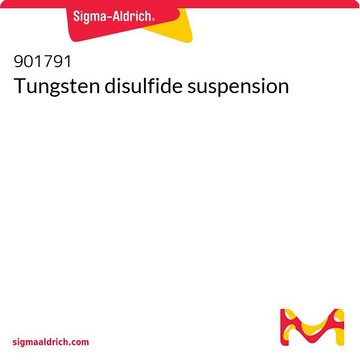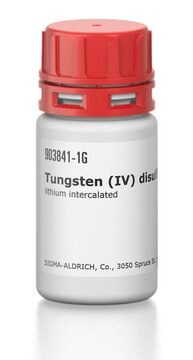901789
Tungsten disulfide nanoplatelets
50-300 nm, thickness < 3 layers, powder
Synonym(s):
2D-Tungsten disulfide, 2D-Tungsten disulfide with nonionic surfactant, 2D-Tungsten sulfide, Tungsten sulfide
Sign Into View Organizational & Contract Pricing
All Photos(1)
About This Item
Linear Formula:
WS2
UNSPSC Code:
12352302
NACRES:
NA.23
Recommended Products
form
nanoparticles
powder
Related Categories
General description
Tungsten disulfide nanoplatelets (WS2) belong to the class of transition metal dichalcogenides (TMDs), which are widely utilized as solid lubricants and chemical catalysts. Their crystal structure has an arrangement in which the sheets of W atoms are sandwiched in between the two planes of S atoms. WS2 has a good polymorphic property that allows tungsten atoms to be covalently bonded with six adjacent sulfur atoms. It also has a good electronic property that makes it useful in optoelectronics applications.
Application
Owing to the thickness dependent physical and chemical properties, the transition metal dichalcogenide (TMD) based two dimensional (2D) nanomaterials have drawn significant attention recently. The atomically thin layers of MoS2 and WS2 represent important class of TMD based 2D-material and they find applications in photocatalysis, phtotovoltaics, gas sensing, lithium ion batteries, field effect transistors, spintronics etc.
Storage Class Code
11 - Combustible Solids
WGK
WGK 1
Flash Point(F)
Not applicable
Flash Point(C)
Not applicable
Choose from one of the most recent versions:
Certificates of Analysis (COA)
Lot/Batch Number
Don't see the Right Version?
If you require a particular version, you can look up a specific certificate by the Lot or Batch number.
Already Own This Product?
Find documentation for the products that you have recently purchased in the Document Library.
Customers Also Viewed
Exploration of Nanostructured Functional Materials Based on Hybridization of Inorganic 2D Nanosheets.
Gunjakar J L, et al.
The Journal of Physical Chemistry C, 118, 3847-3847 (2014)
Nikhita D Mansukhani et al.
Small (Weinheim an der Bergstrasse, Germany), 12(3), 294-300 (2015-12-01)
Conditions for the dispersion of molybdenum disulfide (MoS2) in aqueous solution at concentrations up to 0.12 mg mL(-1) using a range of nonionic, biocompatible block copolymers (i.e., Pluronics and Tetronics) are identified. Furthermore, the optimal Pluronic dispersant for MoS2 is
Sheneve Z Butler et al.
ACS nano, 7(4), 2898-2926 (2013-03-08)
Graphene's success has shown that it is possible to create stable, single and few-atom-thick layers of van der Waals materials, and also that these materials can exhibit fascinating and technologically useful properties. Here we review the state-of-the-art of 2D materials
The super materials that could trump graphene.
Elizabeth Gibney
Nature, 522(7556), 274-276 (2015-06-19)
Global Trade Item Number
| SKU | GTIN |
|---|---|
| 901789-250MG | 4061838634412 |
Our team of scientists has experience in all areas of research including Life Science, Material Science, Chemical Synthesis, Chromatography, Analytical and many others.
Contact Technical Service




